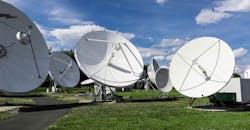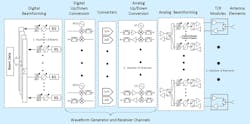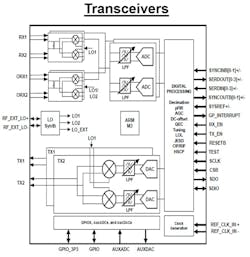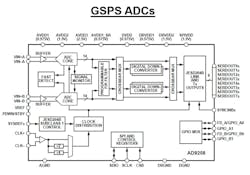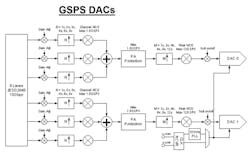Radar Technology Beams Toward the Next Frontier
Download this article in PDF format.
While radar certainly has a long history, tech developments over the last few years have catapulted modern radar systems to new levels of capability. Major advances include gallium-nitride (GaN) technology and high-speed converters. Other significant factors involve digital beamforming, as well as the push for more flexible platforms that can satisfy multiple missions. This article dives into the current radar landscape, examining these topics and more.
Tubes, GaAs, and GaN
Peter Delos is a systems engineer in the aerospace and defense group at Analog Devices. With years of experience in developing radar-system architectures, he can provide valuable insight into today’s radar market. But before speaking about the current market, Delos first offered a historical perspective of radar.
“If we go back to the history of radar, it primarily started in the World War II timeframe,” said Delos. “There were big power tubes and rotating dishes. Then the phased-array world came into fruition, which started in a couple phases. The tubes stayed, but then there were phase shifters and large arrays. That was done all throughout the last century.”
Delos explained when the radar landscape began to change. “Around the late 1990s or so, gallium arsenide (GaAs) came together and the T/R modules came together. That was the first transition to replace tubes in phased-arrays. The radar back-end processing was similar, but the T/R modules flooded the front ends of the phased-array world. That was the first definition of a solid-state array.”
Solid-state technology has continued to advance in recent years. Specifically, as many may already know, GaN technology is now a major factor in today’s radar-system development. “As the power-amplifier (PA) technology improved, the world migrated to GaN,” noted Delos. “We see that as a dominant force going into the future. We’re working actively in that area in terms of PAs and low-noise amplifiers (LNAs).”
While the primary benefits of GaN technology have been well-publicized, other benefits exist that may not receive as much attention. These benefits are significant as well, according to Delos. “There are some secondary benefits of GaN that are really enablers for many customers,” he said. “At the LNA side, there is a higher breakdown voltage. That translates into higher survive power, which can translate into the removal of limiters. That translates to better overall noise figure for the system, which is a big factor. We have GaN LNAs coming out now, as well as some in development that are going to have much higher survive power.”
It’s no secret that GaN PAs play a major role in radar systems. Delos mentioned how these PAs require less current at higher voltages, thereby simplifying the power distribution. Gate switching is another point of interest. He added, “In the past, there was a lot of effort in drain switching to turn the PAs on and off in pulsed-radar applications. Circuits allowed for switching on the drain side. We worked out how to do that on the gate side. Less current drive is needed, and it can simplify and miniaturize some of the circuitry. That’s built into our beamforming integrated circuits (ICs).”
Phased Arrays
Another critical aspect of modern radar systems is phased-array technology. “Most radars now utilize phased arrays,” explained Delos. “In terms of trends, we see that there is a large quest toward digital beamforming. At the lower frequencies, people are trying to enable every element digitally. That’s enabled by our converters and other electronics. As you go up in frequency, the spacing between elements, or what’s called the lattice spacing, goes down. So, the size, weight, and power (SWaP) constraints become very difficult. Therefore, there’s going to be some upper frequency where analog beamforming is necessary.
“Analog beamforming could be utilized for the whole array,” he continued. “Or it could be utilized for subarrays, which is what many call hybrid beamforming. In those cases, you would combine several channels and then go on to digital receivers and waveform generators (Fig. 1).”
1. Shown is a generic analog/digital beamforming phased-array signal flow.
Along these lines is the recently released ADAR1000, which is a four-channel X-/Ku-band beamforming chip. It offers a 31-dB gain adjustment range and a full 360-deg. phase adjustment range. “The ADAR1000 enables digital beamformed arrays where there’s a four-to-one subarray,” noted Delos.
In terms of future radar applications, what scenarios will be better suited for analog beamforming as opposed to digital beamforming? And vice versa? “When it comes to analog versus digital beamforming,” explained Delos, “I think a lot is going to come down to the number of beams. If a single beam is needed, it’s still quite efficient to utilize an analog beamforming solution. If there are multiple beams, the economics of digital beamforming, along with its benefits and flexibility, become very attractive.”
Multi-Mission Systems
When discussing today’s radar systems, one important factor is the greater flexibility required to satisfy multiple missions. “In the past, there was a large set of disparate systems that both American and European governments were making,” said Delos. “But the cost of doing that is no longer palatable. So, there’s a large quest toward multi-mission systems. Essentially, people are trying to get the most flexibility out of any platform. That leads to a system that can handle radar, electronic warfare (EW), and comms.”
However, building these multi-mission systems comes it with its share of challenges. “The next challenge surrounds the somewhat disparate hardware requirements of these different systems when you really break them down,” explained Delos. “At the high level, it may seem like I have this programmable antenna and I can do all these things. But it does lead to challenges, as each of these different systems have some performance differences.
“In terms of the heritage of the companies that make these systems,” continued Delos, “some of them have been doing the same types of things for decades. They may have some tribal knowledge or their own style of doing things—and it’s different in the radar world, the EW world, and the comms world.”
2. Transceivers, such as the one illustrated here, are playing an essential role in radar applications.
Delos added, “Trying to navigate hardware that can be used in all those domains is a challenge. At Analog Devices, we’re right in the middle of that because our converters and transceivers feed into all those applications and we work directly with the engineers to try to pull the next set of electronics together (Fig. 2).”
High-Speed Converters and More
Delos mentioned the converters being utilized today. No doubt, the latest high-speed analog-to-digital converters (ADCs) and digital-to-analog converters (DACs) are enabling factors for next-generation radar systems (Figs. 3 and 4). “Our converter speeds continue to go up,” noted Delos. “The latest ADCs achieve 10 gigasamples per second. That gives us a 5-GHz Nyquist band to work with—that’s really an enabler for wideband systems. A dual 3-GHz ADC is available, and there’s going to be another batch.” According to Delos, these ADCs can essentially make possible wideband systems in miniaturized platforms. Radar, EW, and comms applications are all targets.
3. This block diagram reveals details of a gigasample-per-second ADC.
4. Here’s a closer look at the inner workings of a gigasample-per-second DAC.
Delos further explained the significance of higher converter rates. “In a sense, the converter is the center of the picture because the RF is defined based on the operating band. As the converter speeds increase, the IF frequencies go up and the RF electronics changes—and in most cases really simplifies. Now, you can go directly to L-, S-, and C-band without a mixing stage. A whole RF step has essentially been eliminated.”
One additional point brought up by Delos is the difference in how evaluation (eval) boards are characterized. “If you think historically, we would make an eval board for an ADC and an eval board for an amplifier. We would then hand these off. Now, we make an eval platform that’s a full single chain, so data goes in and RF comes out. That’s one dimension.
“The next dimension is going across channels,” he continued. “We’re making multichannel RF demos to demonstrate coherency and calibration to show that our electronics can fit elegantly into a phased-array solution. We can enable the customers with the demos, as well as learn from the multichannel platforms, since there are little details that we continue to fold into our products.”
Conclusion
This article highlighted some of the activity in today’s radar world. It’s clear that technology has enabled radar systems to undergo a transformation, with GaN PAs and LNAs, as well as high-speed ADCs and DACs, being major driving forces. Digital beamforming is another critical factor. On top of that, the desire for multi-mission systems is redefining the radar market. It would be wise for those involved with radar systems to keep a close eye on what’s coming next in these hotbed areas.
